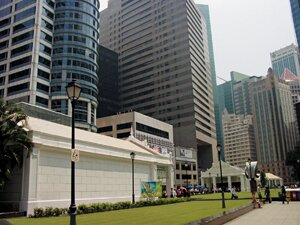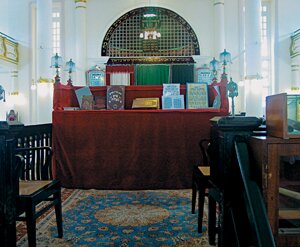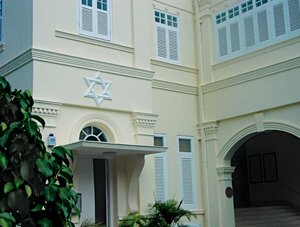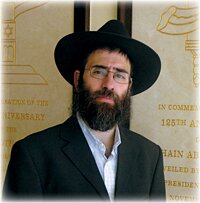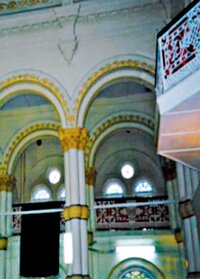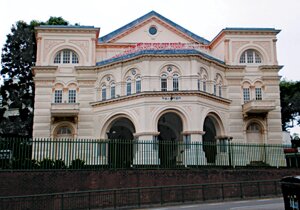| Singapore Jewish Community |

|

|
|
Singapore is a city, an island and a country. Although small, this nation has established itself as a hub for IT, banking and mercantile activities. It attracts people from all corners of the globe and even prides itself on its spirit of multi-cuturalism and acceptance.
Singapore is at the crossroads f numerous international trade routes and has become South-East Asia's most economically The modern country’s history began in 1819 when the Sultan of Johore allowed English businessman Sir Stamford Raffles and the East Indian Company to establish a trading post in Singapore. Five years later he ceded the 200 square mile area to Great Britain. The location of the island made it an ideal port for trade in the Far East, attracting merchants from around the world. By 1830 it is estimated that the Jewish population of Singapore totaled nine and was comprised of traders. In 1840, the Sassoons, a prominent Sephardic family, established business interests in Singapore. The Jewish community The Jewish population, mostly Sephardim, migrated mainly from Baghdad and other communities in the Near East. Later, Jews from Eastern Europe joined the community in search of religious freedom and economic opportunity. By 1879, the community population totaled 172 members, 116 males and 56 females. On April 4, 1878, the new Maghain Aboth Synagogue on Waterloo Street was consecrated. It was a single story building, but an upper gallery for women was added later. Even today, the synagogue counts both Sephardim and Ashkenazim among its members.Â
A 1904 argument with a fellow member of the Maghain Aboth Synagogue led Sir Menasseh Meyer to build his own private synagogue, Chesed-El, in 1905. To obtain the minimum ten men required for communal prayer, Menasseh Meyer employed "Minyan Men." But in 1920, his Minyan Men went on strike, demanding higher salaries and rickshaw fare for their daily services. The Chesed-El Synagogue was built on the grounds of Meyer's luxurious residence on Oxley Rise, and is architecturally magnificent. The deep green trees that surround the structure accent the traditionally designed white exterior of the building. Impressive doorways, windows, and pillars complement the white marble floor, and the gold motifs add to its beauty. In 1905, when the Chesed-El Synagogue was built, there were roughly 500 Jews in Singapore. The community numbered close to 600 Jews in 1911 and 832 Jews in 1931. In 1939, on the eve of World War II, there were 1,000 Jews in Singapore, most of whom were interned by the Japanese during the war. They were forced to wear armbands and medallions with the word Jews inscribed on them; the men had to till the fields. After the war, many of the Jews left for Australia, England, the United States, and Israel. The former president of the Jewish community, David Marshall, stayed in Singapore. He was born in 1908 to a Baghdad-Persian Jewish family and studied law in England before he joined the British Army as a volunteer and traveled to Singapore. When the British granted Singapore partial independence in 1955, Marshall was appointed as the first Chief Minister. But when Great Britain denied Singapore full sovereignty, Marshall resigned from his post in protest. After full sovereignty was finally attained, he was elected to the legislature and later served as Singapore's ambassador to several European countries. Today, Singapore as a whole is comprised of approximately 80% ethnic Chinese, 15% ethnic Malay, and 5% ethnic Indian. The permanent Jewish population is comprised of over 300 members. The community is home to Jews of Baghdadi origin, the original Jewish residents in the region. Expats from the United States, Australia, New Zealand, Morocco, Belgium the UK, and South Africa make-up a large percentage of the Jewish population.
The Jewish community has been headed by Rabbi Mordechai Abergel since 1994. He and his wife, Rebetzin Simcha, have made tremendous contributions to the new found vitality of this community. Together they have opened their home to Singaporean Jews and visitors, sharing their warm atmosphere and welcoming all. There is also a tight-knit Israeli community that exists outside of the greater Jewish community. The Israelis mainly work for the Israeli embassy or military related industries, holding large contracts with the Singapore government. A trade agreement was signed between Israel and Singapore in 1968 followed by the formal establishment of diplomatic relations in 1969. Religious life at both the Maghain Aboth and Chesed-El Synagogues is still active, with daily services, adult education, and other community activities. The Jews of Singapore are fortunate to live in an atmosphere free from anti-Semitism, especially considering their unique location set between Malaysia and Indonesia, two Muslim nations. The Singapore government and Singaporeans overall are known for their acceptance and sensitivity to the particular observances of all religious and ethnic groups. The annually elected Jewish Welfare Board (JWB), created after World War II, manages community affairs. The Jewish Welfare Board is a non-profit organisation which serves the needs of the Jewish community in Singapore and takes care of all the administration for the various departments. The Ganenu program is a day school for pre-school children ages one through six. It runs for six hours a day and qualified teachers are employed to teach various subjects, including English, Mathematics, Science and Hebrew studies. This growing program boasts a current enrolment of over 60 students, with plans for expansion. For other children, the Talmud Torah Hebrew School, a Jewish Sunday school program run by Rabbi Abergal, operates weekly to teach children about various topics related to Judaism. There are forty students enrolled in that program. For the benefi t of the adult community, Rabbi Abergal also initiated Gesher, a group that encourages Jewish awareness and adult education through guest speakers and other events. Additionally there is a Yeshiva Youth Leadership Program in which each year, several Yeshiva Bachurim are hosted to help out in community outreach. They organise activities, hold study sessions and put together social events for the community. This program has touched the lives of nearly every member of Singapore’s Jewish community and brought a new vibrancy and depth to Singapore. The JWB also runs the Abdullah Shooker Home for the Aged in which ten community members reside and are looked after by nurses who take care of their daily meals and other needs.
The Maghain Aboth Synagogue maintains a kosher shop and ensures that the community has access to kosher products. The products include a selection of wines, meats, Israeli goods, and other packaged items. Rabbi Abergal is a trained shochet (ritual slaughterer) and provides the community with fresh chickens on a weekly basis. He has been credited with creating the impetus for wider Kashrut observance within the community. Similarly, the Jewish Cemetery project operates with funding from the benevolence fund which is collected from the community. The cemetery project sees to it that deceased are given the proper burial rites. The Jewish Welfare Board provided funding for the mikveh, located adjacent to the Menorah Club. The facility is equipped with a heater, filter and all the necessary amenities. As Singapore clearly promotes a diverse multi-cultured environment, there is much contact with the local community. The Jewish community participates in an inter-religious organisation in Singapore, a group that encourages religious harmony and mutual understanding. Rabbi Abergel served as the organisation’s vice-president in 1997. He also lectures widely on Judaism for local audiences in order to provide exposure and understanding of Jewish views towards issues facing the world today. The Jews of Singapore have been experiencing a clear growth in the richness of their daily life and development of their institutions. As a tiny ethnic minority they are fortunate to call this island nation home and be welcomed into a culture that prides itself on acceptance and mutual respect.  Fact Box Singapore Jewish Welfare Board Maghain Aboth Synagogue Chesed-El Synagogue  (Issue December 2006/January 2007)  |



















